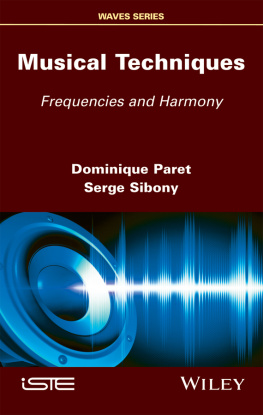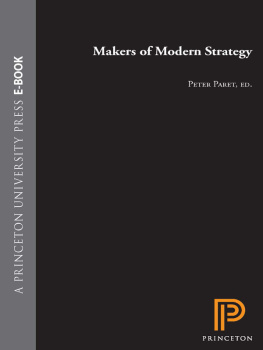Paret Dominique - Musical Techniques Frequencies and Harmonics
Here you can read online Paret Dominique - Musical Techniques Frequencies and Harmonics full text of the book (entire story) in english for free. Download pdf and epub, get meaning, cover and reviews about this ebook. City: Somerset, year: 2017, publisher: John Wiley & Sons Incorporated, genre: Romance novel. Description of the work, (preface) as well as reviews are available. Best literature library LitArk.com created for fans of good reading and offers a wide selection of genres:
Romance novel
Science fiction
Adventure
Detective
Science
History
Home and family
Prose
Art
Politics
Computer
Non-fiction
Religion
Business
Children
Humor
Choose a favorite category and find really read worthwhile books. Enjoy immersion in the world of imagination, feel the emotions of the characters or learn something new for yourself, make an fascinating discovery.
- Book:Musical Techniques Frequencies and Harmonics
- Author:
- Publisher:John Wiley & Sons Incorporated
- Genre:
- Year:2017
- City:Somerset
- Rating:5 / 5
- Favourites:Add to favourites
- Your mark:
- 100
- 1
- 2
- 3
- 4
- 5
Musical Techniques Frequencies and Harmonics: summary, description and annotation
We offer to read an annotation, description, summary or preface (depends on what the author of the book "Musical Techniques Frequencies and Harmonics" wrote himself). If you haven't found the necessary information about the book — write in the comments, we will try to find it.
Musical Techniques Frequencies and Harmonics — read online for free the complete book (whole text) full work
Below is the text of the book, divided by pages. System saving the place of the last page read, allows you to conveniently read the book "Musical Techniques Frequencies and Harmonics" online for free, without having to search again every time where you left off. Put a bookmark, and you can go to the page where you finished reading at any time.
Font size:
Interval:
Bookmark:

- 1 Sounds, Creation and Generation of Notes
- 2 Generation of Notes
- 3 Recreation: Frequencies, Sounds and Timbres
- 4 Intervals
- 5 Harshness, Consonance and Dissonance
- 6 Scales
- 7 Scales, Degrees and Modes
- 9 Chords
- 11 Examples of Harmonic Progressions
- 12 Examples of Harmonizations and Compositions
- 1 Sounds, Creation and Generation of Notes
- 2 Generation of Notes
- 3 Recreation: Frequencies, Sounds and Timbres
- 4 Intervals
- 5 Harshness, Consonance and Dissonance
- 6 Scales
- 9 Chords
- 12 Examples of Harmonizations and Compositions
- Appendix Acoustic (Harmonious) Effects
Dominique Paret
Serge Sibony

First published 2017 in Great Britain and the United States by ISTE Ltd and John Wiley & Sons, Inc.
Apart from any fair dealing for the purposes of research or private study, or criticism or review, as permitted under the Copyright, Designs and Patents Act 1988, this publication may only be reproduced, stored or transmitted, in any form or by any means, with the prior permission in writing of the publishers, or in the case of reprographic reproduction in accordance with the terms and licenses issued by the CLA. Enquiries concerning reproduction outside these terms should be sent to the publishers at the undermentioned address:
ISTE Ltd
27-37 St Georges Road
London SW19 4EU
UK
www.iste.co.uk
John Wiley & Sons, Inc.
111 River Street
Hoboken, NJ 07030
USA
www.wiley.com
ISTE Ltd 2017
The rights of Dominique Paret and Serge Sibony to be identified as the authors of this work have been asserted by them in accordance with the Copyright, Designs and Patents Act 1988.
Library of Congress Control Number: 2016960997
British Library Cataloguing-in-Publication Data
A CIP record for this book is available from the British Library
ISBN 978-1-78630-058-4
You hold in your hands a book which has been a very long time in coming, which begun and then languished in a drawer for nearly fifteen years, owing to the flood of professional responsibilities which took priority! Having met Serge Sibony as an adolescent a few years ago, and then later discovered his books in harmonics aimed at professional musicians, this inspired me to return to my true passions, and finish this book, whose express purpose is to bridge the divide, starting with aspects which even neophyte musicians could understand, and ultimately reaching the supreme level represented by harmonic research and the meticulous constructions of harmony grids presented by Serge and other well-known authors!
As this book is written by an academic and an accomplished musician, readers will not be surprised by the theoretical and Cartesian aspect of certain parts of it, but rest assured, harmony true harmony; that which brings pleasure to the ears always lies just below the surface.
As per usual, there are many people deserving of thanks, for their goodwill, their listening, their remarks and constructive comments. Thus, to all those people, who know perfectly well who they are: a huge and heartfelt thanks!
Now, though, I address a few acknowledgements and more specific thoughts to some long-standing friends:
- to Patrice Galas who, without knowing, inspired this book, for whom harmony, which is so complicated, is so easy to explain! Patrice, who is a composer, and renowned jazz concert musician on the piano and the Hammond organ (having played with Georges Arvanitas, Kenny Clarke, Marc Fosset, Philippe Combelle, and many more) was one of the first to teach jazz in the conservatories and at the C.I.M.
- (Centre dinformation musicale, in Paris). With pianist Pierre Cammas, he has devised several methods of repute, with the title La Musique Moderne, tracing a century of music, from blues to modern jazz, and also contributed to the Dictionnaire du Jazz published by Robert Laffont;
- to Serge Sibony, my co-author, for his wealth of musical knowledge, his unfailing friendship, and his help;
- to Henri Sibony Serges father: a very old friend of mine who, long ago, in France, was technical director for Lowrey Organs a renowned American maker of classical and jazz apartment organs of high standard;
- to two friends and talented musicians: Pascal Roux a conductor at Daniel Rousseau a pianist who were good enough to read this manuscript and give detailed, constructive feedback on the content of the book. Thanks also go to Jean-Paul Huon, who acted as the Beta test reader!
- finally, I devote this book to the memory of a) Monica Sibony, and b) Jean-Claude Hamalian a classical pianist, and lover of (great) music, who was the founder/director of one of the greatest musical instrument shops in Cte dAzur, in Saint-Laurent-du-Var.
Many thanks to those who, in their own way, have given me wonderful musical experiences, in terms of melodies, harmonies, technical advice and happiness shared.
DOMINIQUE PARET
For many years now, having been in search of a simple treatment, of high level and easily accessible regarding harmony, its musical-, physiological- and social roots and the way it works, we have bewailed the lack of one. We have found either highly simplistic books, or treatises on harmony that only a post-doctoral student could begin to understand. With the exception of a few books cited in the bibliography, the field is a huge desert! Not satisfied by this intellectual state of affairs, we screwed our courage to the sticking-place to research and write this book: Musical Techniques: Frequencies and Harmony, as a sort of passport to/for harmony, in the hope that it will go some way towards filling that void.
The construction of this book is extremely simple! Musical Techniques: Frequencies and Harmony is intended to be a pleasant and instructive springboard for readers to be able, one day, to cope with true treatises on harmony. With this goal in mind, it is divided into three main sections:
- in is a long pathway and a very detailed view of things which are (almost) well known to some people, but entirely new to many others;
- , in turn, dips a toe in harmony. We look at the structure, the content, the wherefore and the qualities of a group of notes played simultaneously, forming a chord: in summary, everything which has anything to do with a chord is taken, for the time being, in isolation and in an untimely manner;
- of this book consist of resolutely getting a foot in the door: a small foot, but a foot nonetheless, in everything to do with how to understand, construct and perform successive series of harmonic progressions of groups of notes, played in a chord, so we can see how to harmonize, reharmonize, create partitions, improvise, etc., and succeed in getting a foot in the stirrup so as to be able to go further with books on harmony at the higher end of the scale the major scale, of course!
Font size:
Interval:
Bookmark:
Similar books «Musical Techniques Frequencies and Harmonics»
Look at similar books to Musical Techniques Frequencies and Harmonics. We have selected literature similar in name and meaning in the hope of providing readers with more options to find new, interesting, not yet read works.
Discussion, reviews of the book Musical Techniques Frequencies and Harmonics and just readers' own opinions. Leave your comments, write what you think about the work, its meaning or the main characters. Specify what exactly you liked and what you didn't like, and why you think so.









